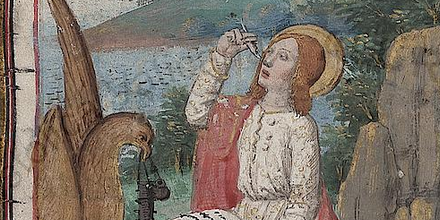The Vatican codex was part of the second volume of a collection of homilies by the patristic author Gregory of Nazianzen. It seems to have been copied in the ninth century, possibly in Constantinople, and it later entered the library at the monastery of St. Catherine on Mount Sinai in Egypt.
A large chunk of it was taken from there between 1718 and 1721 by a Maronite priest, Andrea Scandar. In Rome, Scandar deposited five books he had taken from St Catherine's including this item.
One very much doubts this was a legitimate removal (there's now a project to trace purloined Sinai manuscripts). A couple more folios were souvenired from Sinai in 1844 by the German Lutheran scholar Konstantin von Tischendorf, who is best known for spiriting away much of the Codex Sinaiticus Greek Bible from the same library. Tischendorf's folios of Gregory's Homilies are now in Leipzig, Germany. "His" folios are bound in Cod. gr. 69 there, but have not yet been digitized.
In an interesting piece of scholarly detective work, on which I rely for the account above, Orsini has now identified more folios that are still at St Catherine's. We might see them digitized some day too.
The full list of five digitizations on May 11 and 13, which brings the front-page total to 1,985:
- Barb.lat.387: Orationes septem sancti Gregorii papae with fine 15th-century illuminations. The picture above shows John the Evangelist on Patros. The eagle (John's symbol) is holding his ink supply. It's your guess as to why this Italianate John needs to tickle one nostril with a feather. Perhaps the artist just meant that hand to be held to John's ear, waiting for the word of God to arrive, ready to stab quill-pen to papyrus to take dictation, but the composition is unfortunate.
- Barb.lat.4295: shows coats of arms, from the library of Federico da Montefeltro
- Borg.ill.1: this seems to be a bilingual Croatian-Latin text with glossary containing a church history and scriptures in Croatian (in a form of Cyrillic script) by the 17th-century Croatian archbishop Andrea Zmaievich
- Ott.gr.424: Gregory of Nazianzen, as described above
- Ott.lat.66: the Codex Ottobonianus, copied in North Italy in the 7th or 8th century: it contains the Heptateuch in the Vulgate version interspersed with portions in the older Vetus Latina text. See the next post.




No comments :
Post a Comment